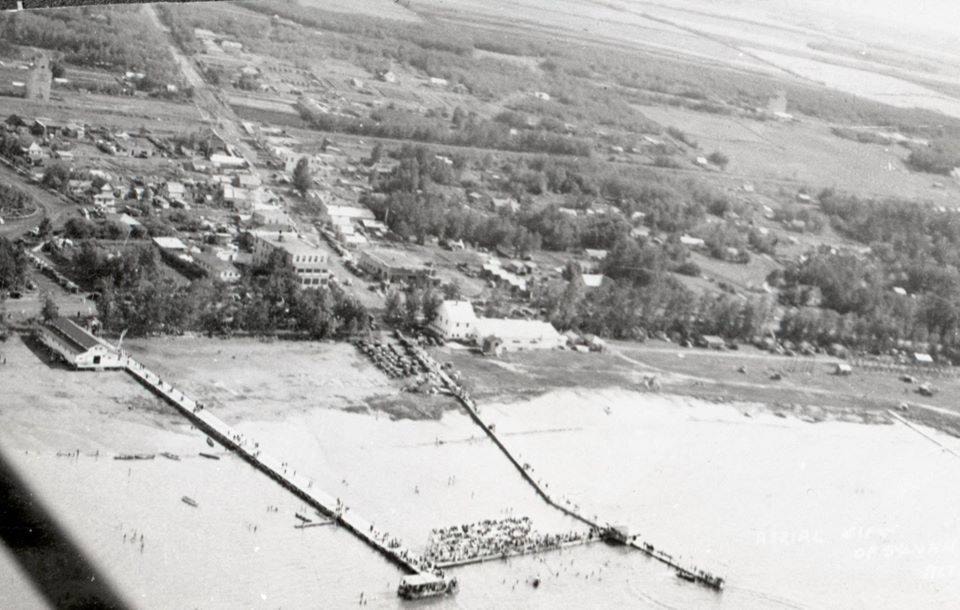Sylvan Lake is one of Alberta’s most popular resorts. Huge numbers of people flock there every year to take in the lake and its many attractions.
For a great many years, Sylvan Lake was also the scene of a major sporting event – the annual Wrigley Swim competitions.
The origins of the Wrigley Swim competitions go back to 1927. William Wrigley Jr., the founder of the Wrigley chewing gum company, was always looking at ways to boost the sales of his products.
Becoming a sponsor of sports was often used for promotions. One example was Wrigley’s purchase of the Chicago Cubs.
Wrigley also had major investments in Catalina Island in California. Impressed by the public interest in marathon swimmers crossing the English Channel, he decided to stage the Catalina Ocean Marathon in early 1927.
Swimmers were to compete for a $25,000 prize while crossing the 35-kilometre-wide Catalina Channel.
Only George Young, a 17-year-old Canadian, was able to complete the race.
While the Catalina Marathon was never held again, Wrigley decided to hold swim marathons in conjunction with the annual Canadian National Exhibition in Toronto, as that was where Young was from.
The CNE marathons attracted huge attention across North America. However, like the Catalina Marathon, they were gruelling events. In 1929, the event collapsed when very cold water, as well as attacks by eels and lampreys, meant no one finished the race.
Wrigley decided to revamp his approach. He liked the idea of continuing to sponsor swimming competitions. However, he decided to support annual outdoor long-distance swimming championships in conjunction with the Canadian Amateur Swimming Association and several affiliated provincial associations.
The first Wrigley Swim in Alberta was staged on July 25, 1931, at Aspen Beach Provincial Park during the annual Gull Lake Regatta. Lt.-Gov. W.L. Walsh officially opened the event. The weather was excellent and the crowds were large.
Hence, the next Wrigley Swim was held at Gull Lake on July 20, 1932. Again, the weather was great. More than 5,000 spectators turned out.
The crowds were so large that the government pier became overcrowded. The diving platform capsized because of the number of onlookers who had climbed onto it.
In 1933, the Wrigley Swim was moved to Sylvan Lake, to be held in conjunction with the annual Sylvan Lake Regatta.
Once again, the weather was hot and dry. Newspaper reports recorded that more than 10,000 people turned out to watch the swim competitions and other events.
In 1934, a half-mile competition for juniors (both male and female) was added to the main Wrigley mile-long race for men and women.
The annual Wrigley Swims continued to be held at Sylvan Lake for the next several years, even though some years provided rather challenging weather.
On some occasions, the events were staged on the inshore side of the main piers. That way, the competitors had some protection from the winds and choppy waters.
The Sylvan Lake Service Club did much of the organizing of the event. In 1936, to handle all of the spectators, a large set of grandstand-style bleachers was installed on a connecting pier between the two main piers.
With the outbreak of the Second World War, the Wrigley Swims continued to be held. However, in 1942, the events were moved to Edmonton, where large pools were available.
The Wrigley Swims returned to Sylvan Lake in 1947. However, weather conditions remained a problem. Also, ice often damaged the piers, leaving sections missing or unstable during some years’ competitions.
By the early 1950s, there were increasing numbers of formal pools in many of Alberta’s cities. The last Wrigley Swim competition was held at Sylvan Lake in 1953.
After that, the Wrigley Swims were held in Edmonton or Calgary, with occasional competitions in other centres.
The Wrigley trophies for long-distance competitive swimming continued to be awarded every year as part of the provincial and national swimming championships for several more decades.
Red Deer historian Michael Dawe’s column appears Wednesdays.
